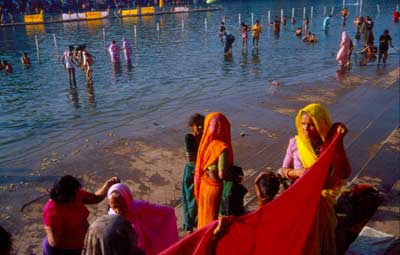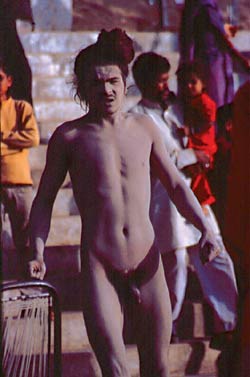|
Special Features
Snan Parva or Ritual Bath, Haridwar Kumbh 2010 |
|||||
The Maha Kumbh is celebrated at Haridwar every 12 years. The great bathing festival of the Kumbh Mela at Haridwar is in 2010. Ceremonial bathing in the sacred Ganga as she descends from her celestial home to journey through the Himalayas to the plains of India, is a sacred ritual from time immemorial. The Kumbh Snan Parva is much more significant than a ritualistic dip in the holy river. It is a tribute to the Hindu way of life, an affirmation of faith and a renewal of our deep-seated beliefs. The holy bath at a Kumbha is said to be equal in merit to thousands of snans during the month of Kartik, hundreds of Magh snans and crore snan in the river Narmada during Vaishakh. Its fruit is said to be equivalent to thousands of Ashwamegh Yajna, hundreds of Vajpaye Yajna, and lakhs of parikrama around the world. |
More on Kumbha •Nashik Kumbha 2015 • Ujjain 2016 • Legends of Kumbha • Practical Guide • Sadhus at Kumbha • Photo Gallery 1 • Photo Gallery 2 • Photo Gallery 3 • Kumbh Haridwar 2010 • Kumbha Allahabad 2013 • Ujjain 2004 • Notes from the Kumbh • Friend to Sage • Vignettes Kumbha Cities • Ujjain • Haridwar • Allahabad • Nashik |
||||
 Snan Parva or Bathing Dates
Snan Parva or Bathing Dates Though the Mela period extends from January till the end of April, most camps will be fully operational during the main bathing dates, particularly during Mahashivatri on 12th February, for Somavati Amavasya on 15th March through the sacred Navaratri period till Ramanavami on 24th March. The Baisakhi shahi snan on 14th April will also find a surge of pilgrims. While the entire period is considered auspicious, there are several main bathing dates. It is well advised not to travel in the area on a bathing date, but arrive and depart with a minimum of a day's gap, because vehicular traffic is restricted on bathing dates and at all peak periods.
The Kumbh is mythologically related to the churning of the oceans to extract amrit or the nectar of immortality. The devatas or gods and the asuras or demons, together churned the oceans. The pot of ambrosia was handed to Brihaspati, (Jupiter) Surya,(Sun) Chandra (Moon) and Shani (Saturn). In the process of the ensuing tussle to get it, which lasted 12 god-days, equal to 12 human years, a few drops spilled from the kumbh or pitcher in which the Amrita was being carried. This nectar fell at Allahabad, Haridwar, Nasik and Ujjain, sanctifying these places. The Kumbha Mela is held at these four sacred places - on the banks of the holy Ganga at Haridwar where it descends from the mighty Himalayas to the plains of India, at the confluence of the Ganga, Yamuna and the mythical Saraswati called the Triveni Sangam at Prayag or Allahabad, beside the river Kshipra at Ujjain and on the banks of the Godavari at Nasik. At each of the four places the Kumbh festival is celebrated once every twelve years, coinciding with one round of Jupiter through the zodiac. Since the three cosmic powers played their role, the Kumbha is celebrated when Jupiter, the Sun and Moon are in particular astrological positions in the almanac. When Jupiter is in in the sign of Aquarius, when the sun is in Aries and Moon is in Sagittarius, the Auspicious Kumbh at Haridwar occurs. When Jupiter is in Taurus and the Sun and Moon in Capricorn, it is celebrated at Prayag or Allahabad. At Nasik it is held when Jupiter is in Leo and the Sun and Moon are in Cancer. At Ujjain the Kumbh Mela occurs when Jupiter is in Leo and the Sun and Moon in Aries. |
|||||
Editor: Romola Butalia (c) India Travelogue. All rights reserved. |
|||||
 At Haridwar, there are many bathing ghats, the chief one being at Har Ki Pauri. It is said to have been constructed by King Vikramaditya in memory of his brother, Bhartrihari, who is believed to have come to Haridwar to meditate on the banks of the sacred Ganga. While some historians date Vikramaditya's reign as first century BC others suggest it was in the sixth century AD. This bathing ghat is also known as Brahmakund Ghat. The other well-known ghats in Haridwar are Ram Ghat, Vishnu Ghat, Asthi Parwah Ghat, where the ashes of the deceased are immersed, Subhash Ghat named after Netaji Subhash Chandra Bose, and Gau Ghat where the sin of gau-hatta or cow slaughter is atoned for.
At Haridwar, there are many bathing ghats, the chief one being at Har Ki Pauri. It is said to have been constructed by King Vikramaditya in memory of his brother, Bhartrihari, who is believed to have come to Haridwar to meditate on the banks of the sacred Ganga. While some historians date Vikramaditya's reign as first century BC others suggest it was in the sixth century AD. This bathing ghat is also known as Brahmakund Ghat. The other well-known ghats in Haridwar are Ram Ghat, Vishnu Ghat, Asthi Parwah Ghat, where the ashes of the deceased are immersed, Subhash Ghat named after Netaji Subhash Chandra Bose, and Gau Ghat where the sin of gau-hatta or cow slaughter is atoned for.